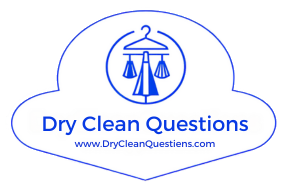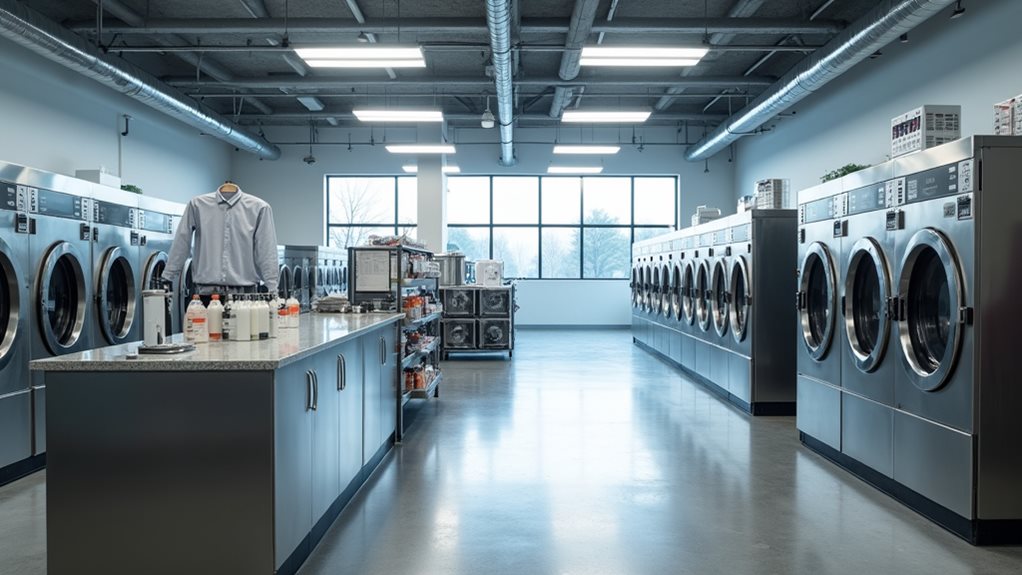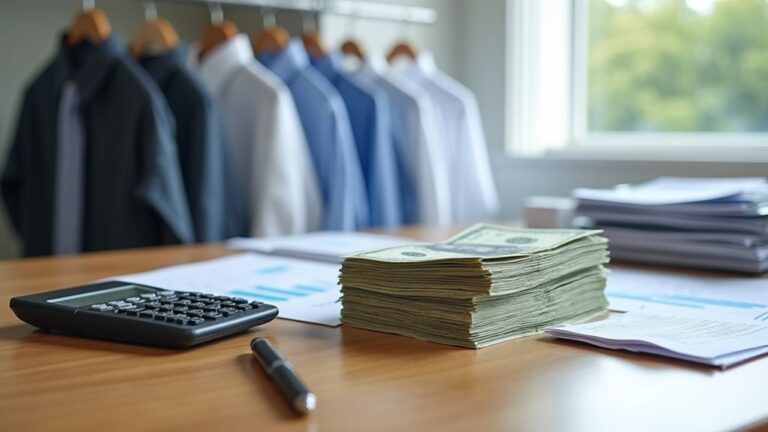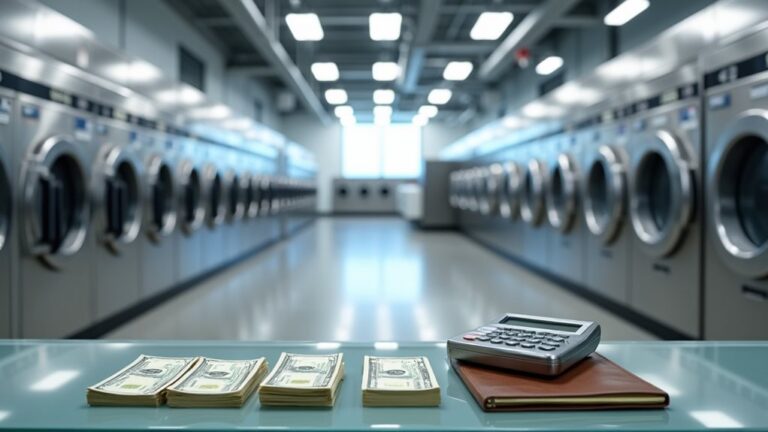Starting your dry cleaning business will cost you anywhere from $20,000 to $500,000, and honestly, that wide range used to surprise me until I realized how many different paths you can take. You’ll spend $15,000-$70,000 on equipment alone, plus $2,500-$9,000 monthly for commercial space, and don’t forget licensing fees of $2,000-$10,000. The beauty lies in choosing your model wisely—drop locations need under $50,000 while full storefronts require over $100,000, and exploring these options reveals even more cost-saving strategies.
Initial Investment Requirements for Dry Cleaning Businesses
When I first considered opening my dry cleaning business three years ago, I nearly choked on my morning coffee ☕ when I discovered the startup costs could swing anywhere from $20,000 to half a million dollars, depending on whether you’re thinking strip mall or prime downtown real estate.
I nearly choked on my coffee when I discovered dry cleaning startup costs range from $20,000 to half a million dollars.
Your initial investment breaks down into several key buckets, with crucial equipment being the biggest bite—expect $15,000 to $40,000 for basic machines, though high-quality dry cleaning equipment can exceed $70,000.
Commercial property costs will run you $2,500 to $9,000 monthly, while marketing expenses start modestly at a few hundred dollars.
Don’t overlook essential startup expenses like licensing and permits, which typically cost between $2,000 and $10,000 depending on your location and local regulations.
Here’s my hard-learned advice: reserve 20-25% of your funding for operating expenses, because financial stability during those nail-biting first months depends on having adequate cash reserves when customers are still discovering your location.
Commercial Property and Location Expenses
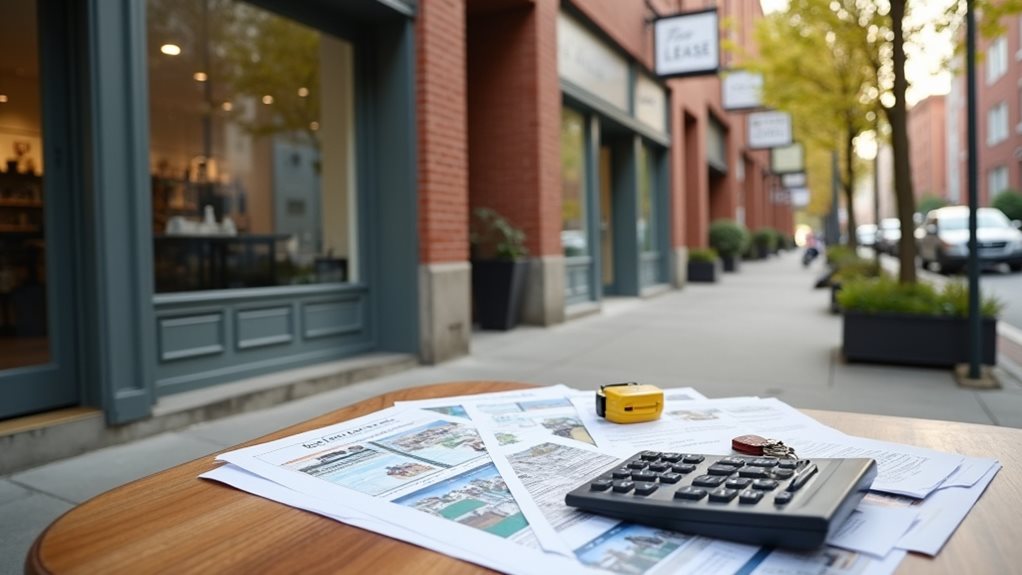
When I first scouted locations for my cousin’s dry cleaning venture, I quickly learned that choosing between renting and purchasing commercial property isn’t just about monthly payments—it’s about understanding your long-term vision and cash flow reality.
You’ll face rental costs ranging from $2,500 to $9,000 monthly depending on your market, plus those pesky upfront deposits that can drain your startup funds faster than you’d expect.
The location factors that’ll make or break your business success go far beyond just finding affordable square footage, because visibility and customer accessibility will ultimately determine whether you’re counting profits or wondering where all your customers went. 😅
Strategic location selection in high-traffic areas with your target demographics of busy professionals and families is crucial for establishing the steady demand that makes dry cleaning businesses profitable.
Rental Vs Purchase Costs
After scouting dozens of potential locations for my first dry cleaning business, I learned that choosing between renting and purchasing commercial property isn’t just about monthly payments—it’s about understanding your long-term vision and financial comfort zone.
Rental costs typically range from $2,500 to $9,000 monthly, plus security deposits, making them easier on startup costs but offering no equity building.
Purchase costs hit harder upfront—$90,000 to $550,000—with renovation costs adding another 10-15% of the property value, but you’ll own appreciating assets.
Don’t forget ongoing expenses like property taxes (3-12% annually) and monthly costs that accumulate regardless.
Always verify zoning regulations first; I’ve seen entrepreneurs face costly legal headaches when commercial property doesn’t match their business needs. 📍
Remember that storefront renovations typically account for a significant portion of your initial investment, with renovation costs ranging from $30,000 to $100,000 depending on the condition and size of your chosen location.
Location Selection Factors
Success in the dry cleaning business hinges on one fundamental truth I discovered during my property hunt: your location determines whether customers will find you easily or drive past without noticing you exist.
When evaluating location selection factors, you’ll need to balance commercial property costs with strategic positioning that maximizes your success potential.
Here are four crucial considerations for choosing your commercial space:
- Visibility and access – Position yourself where busy professionals can easily spot your storefront during their daily commutes.
- High foot traffic areas – Target commercial districts near office buildings where your target customers naturally congregate.
- Ample parking availability – Guarantee customer convenience with accessible parking that doesn’t require hiking three blocks 🚗.
- Zoning regulations compliance – Verify operational feasibility by confirming your location meets all legal requirements before signing anything.
Additionally, consider implementing pickup and delivery services to expand your customer reach beyond your immediate physical location, which can help offset higher rent costs in premium areas by serving customers who value convenience over proximity.
Equipment and Machinery Costs
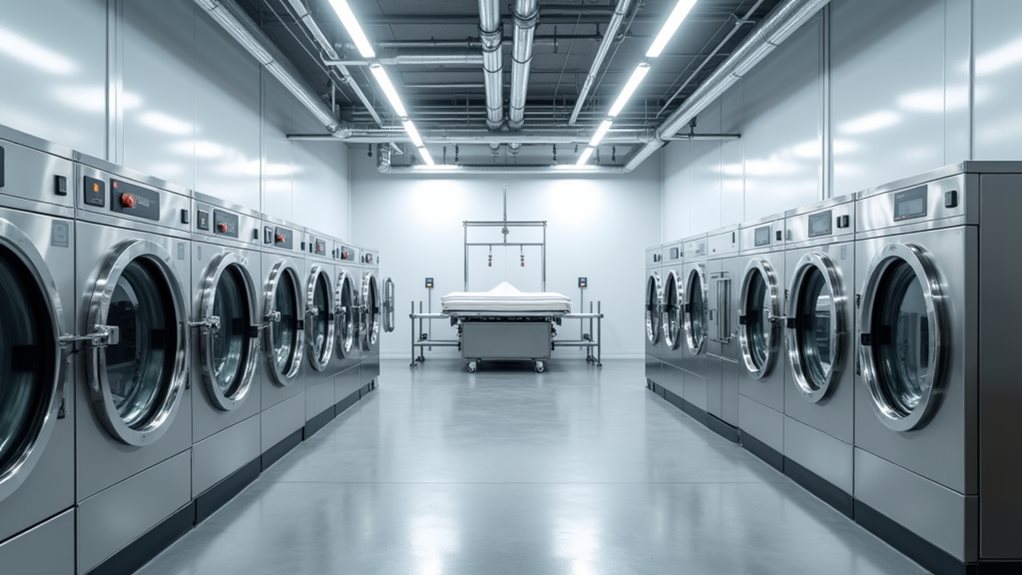
Five major equipment categories will shape your dry cleaning startup budget, and honestly, the numbers might make you gulp that morning coffee a little harder than usual.
Basic dry cleaning machines run between $10,000 and $50,000, though high-end models can push past $70,000 if you’re feeling ambitious.
Laundry machines for wash-and-fold services add another $2,000 to $10,000 to your startup costs, while pressing equipment demands $2,000 to $5,000 for quality steam irons and boards.
Don’t forget conveyor systems at $1,000 to $5,000, because trust me, efficient garment handling saves your sanity during busy periods.
Finally, Point of Sale (POS) systems cost $1,000 to $3,000, crucial for tracking transactions and inventory without losing your mind.
These equipment investments are essential since successful dry cleaning businesses often supplement income through additional services like alterations, shoe repair, or laundry services to maximize profitability.
Licensing and Permit Fees
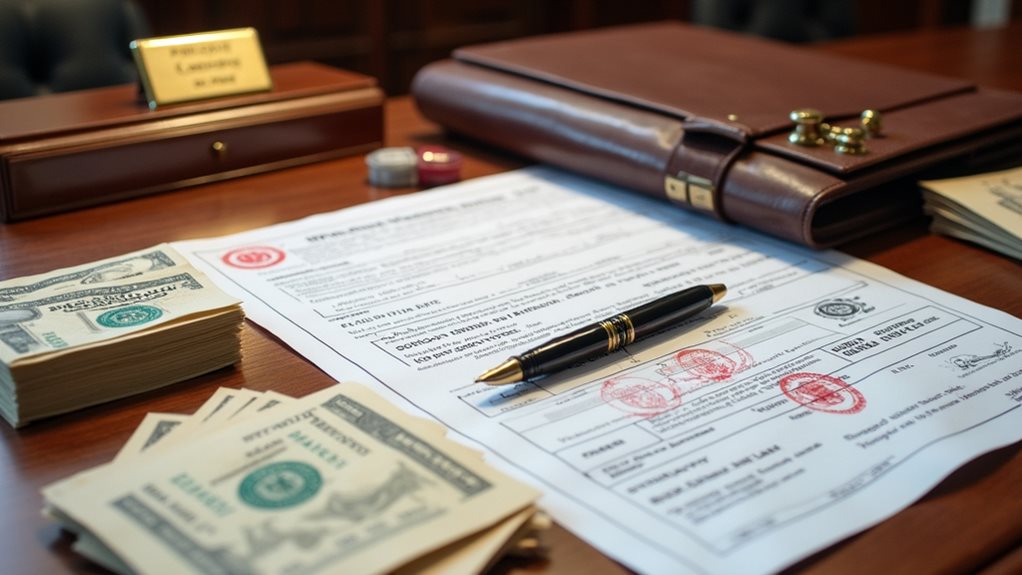
You’ll need to traverse a maze of licensing requirements that can feel overwhelming at first, but trust me, getting these permits sorted early will save you countless headaches down the road.
The required business licenses vary dramatically by state, ranging from a simple $100 fee to over $1,000, and I learned the hard way that procrastinating on these applications can delay your opening by weeks.
Environmental permits deserve special attention since you’ll be handling chemical solvents, and while these permits might cost you $50 to $300, they’re absolutely vital for operating legally and protecting both your customers and the community around you.
Additionally, you’ll want to conduct thorough market research to understand local competition and identify your target customers before finalizing your licensing strategy.
Required Business Licenses
Before I learned this lesson the hard way, I wish someone had told me that traversing the maze of business licenses for your dry cleaning venture can feel overwhelming at first, but breaking it down into manageable pieces makes the whole process surprisingly straightforward.
Here’s what you’ll typically need to obtain:
- General business license – Your basic operating permit, usually $50-$500 depending on location.
- Laundry/dry cleaning specific license – Required in most states with proof of lease or ownership.
- Environmental permits – Crucial for chemical usage, ranging $100-$3,000 based on local regulations.
- Zoning compliance verification – Guarantees your location meets local zoning laws requirements.
Don’t forget about annual renewal fees, typically $100-$300, when creating your financial projections.
Proper compliance protects your operating procedures and prevents costly shutdowns that could derail your entire business.
According to industry estimates, total licensing and permits typically range from $1,000 to $5,000 as part of your overall startup investment.
Environmental Permit Costs
Environmental permit costs represent the most considerable expense within your licensing budget, and frankly, they caught me completely off guard when I first calculated my startup costs.
Your dry cleaning business will face state regulations that vary dramatically, with environmental permit costs ranging from $500 to $5,000 depending on your location.
You’ll also need a specific dry-cleaning license costing $300 to $1,500, plus additional permits for hazardous materials that require registration and compliance fees of $200 to $2,000.
Don’t forget about annual renewal fees ($100 to $1,000) and inspections and testing fees adding several hundred dollars yearly to your ongoing operational costs.
These regulatory requirements are particularly important as you enter a global industry valued at approximately $90-100 billion worldwide, where compliance with environmental standards is essential for sustainable operations.
Budget generously here – these environmental requirements aren’t optional!
Staffing and Payroll Considerations
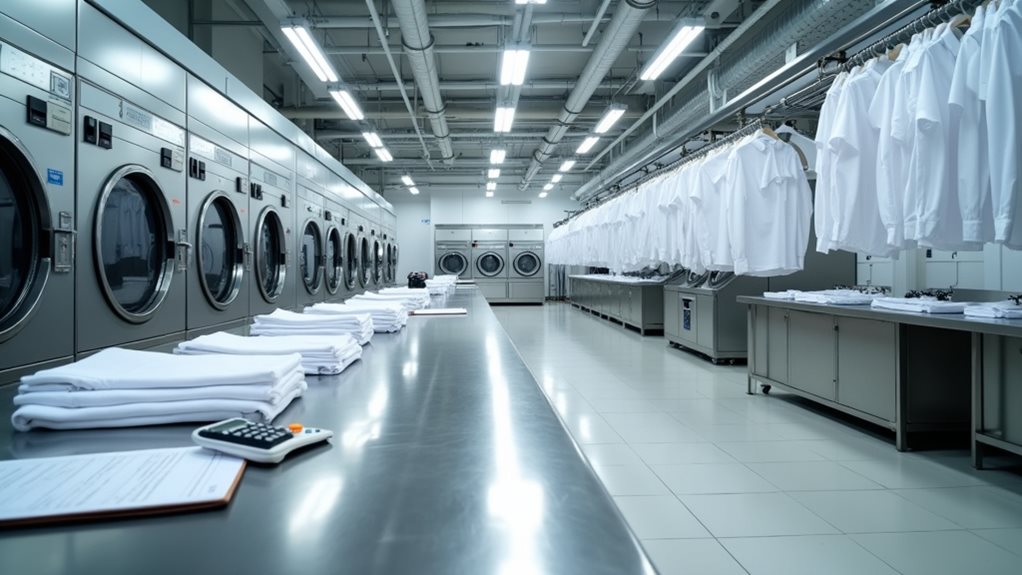
While many entrepreneurs focus heavily on equipment and location when planning their dry cleaning venture, the reality is that your staffing decisions will make or break your business’s daily operations and long-term profitability.
Your staffing budget will typically range from $12,000 to $25,000 for the first month, and trust me, every dollar matters when you’re calculating those essential financial projections.
Every dollar in your $12,000-$25,000 first-month staffing budget directly impacts your dry cleaning business’s financial success.
Here’s what you’ll need to evaluate for your dream team:
- Skilled staff who understand fabric care and chemical handling
- Customer service representatives to manage front-desk operations
- Garment handling assistants for sorting and quality control
- Ongoing training programs to maintain service excellence
Employee compensation should align with industry standards—because underpaying leads to turnover nightmares! 😅
Your thorough payroll plan directly impacts operational efficiency and employee retention, so invest wisely. Building a loyal customer base through quality service is essential for achieving those profit margins that typically range from 15-25% for well-managed operations.
Business Model Options and Their Financial Impact
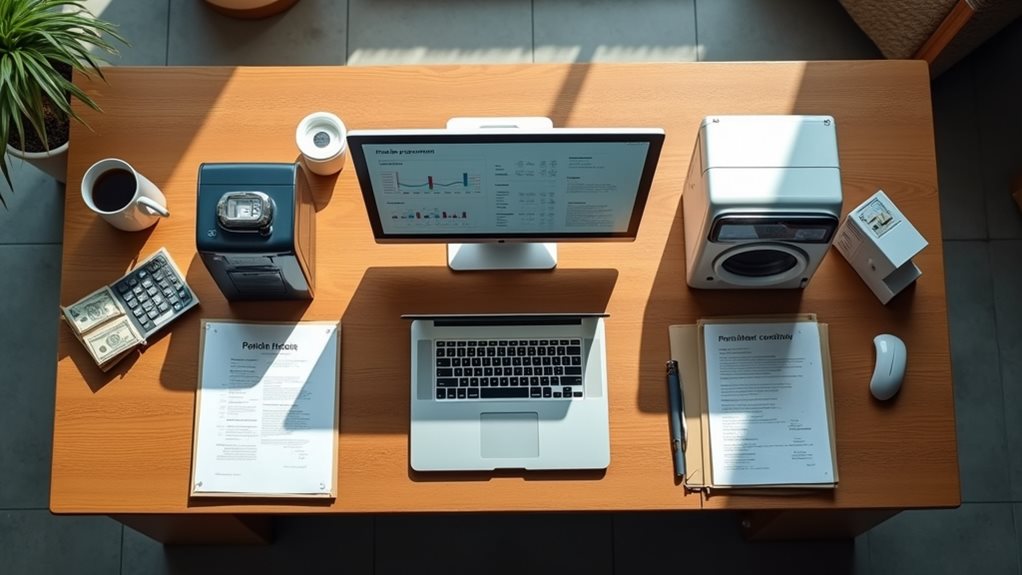
Now that you’ve wrapped your head around staffing costs, it’s time to examine how your chosen business model will either fuel your financial success or drain your bank account faster than you can say “starch and press.”
I learned this lesson the hard way when I first assumed all dry cleaning businesses operated the same way—spoiler alert, they absolutely don’t!
Your startup costs swing wildly between $20,000 and $500,000 depending on which path you choose. The traditional storefront model demands serious commitment, typically requiring over $100,000 for your initial investment.
However, drop locations offer breathing room with under $50,000 needed, while delivery services can launch similarly affordably.
Smart entrepreneurs diversify income streams by combining models, maximizing revenue potential without putting all eggs in one physical storefront basket.
Before committing to any model, ensure you’ve obtained all necessary business licenses and permits required for your specific dry cleaning operation.
Financing Solutions for Your Dry Cleaning Venture
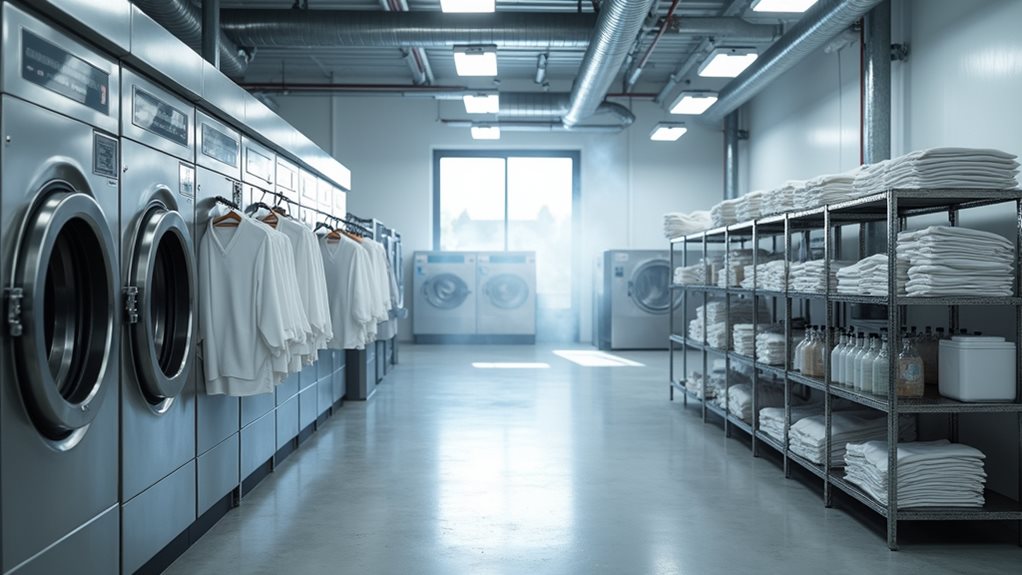
Most entrepreneurs discover that securing funding for their dry cleaning venture feels like traversing a financial maze blindfolded, especially when you’re staring at investment requirements that range from a modest $20,000 to a heart-stopping $500,000.
Your financing solutions depend heavily on crafting a well-crafted business plan with solid financial projections that’ll make lenders smile instead of cringe.
Here’s your funding roadmap:
- Small business loans and SBA-backed loans – Traditional routes offering structured repayment terms
- Personal savings – Your safest bet without owing anyone explanations
- Crowdfunding platforms – Modern solutions where strangers fund your dreams
- Family investments – Mixing business with pleasure (proceed with caution! 😅)
Hidden Costs and Ongoing Operational Expenses
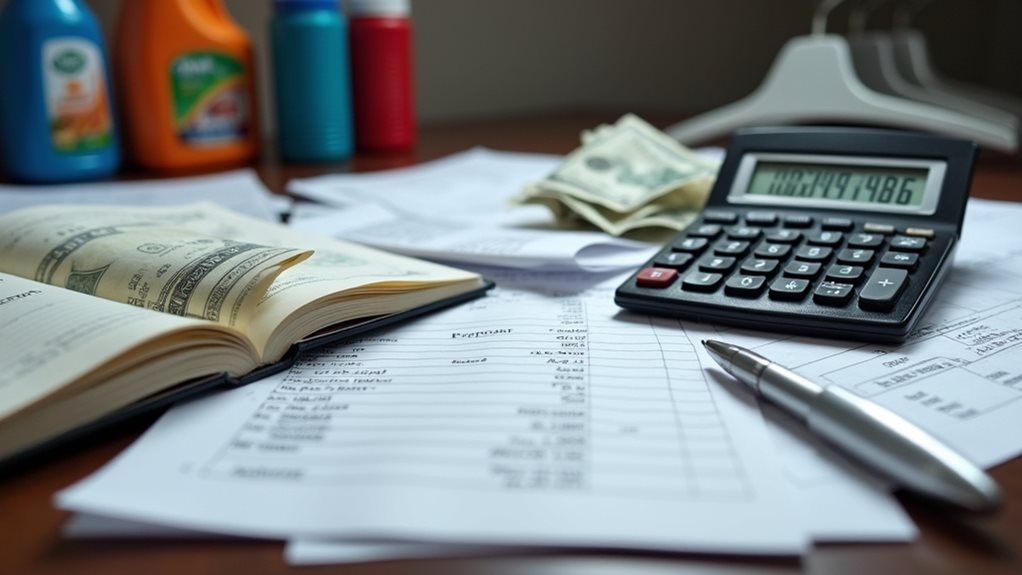
Although you’ve carefully calculated your startup costs down to the last penny, the dry cleaning business has a sneaky way of introducing expenses that’ll make you question your math skills. Honestly, I learned this the hard way when my friend Sarah opened her first location only to discover that “move-in ready” apparently meant “ready for someone with a construction background and deep pockets.”
Hidden costs lurk around every corner like financial ninjas, starting with those inevitable renovation surprises that typically add 10-15% to your property purchase price, or several thousand dollars if you’re renting. This is because that “minor plumbing issue” mentioned in passing suddenly requires rerouting half the building’s water system.
Ongoing operational expenses create their own financial rhythm, with monthly utilities dancing between $1,000-$3,000 depending on your commercial laundry equipment’s appetite for power.
Employee payroll demands $12,000-$25,000 upfront, while insurance costs and maintenance expenses add thousands more annually to your unexpected expenses tally.
